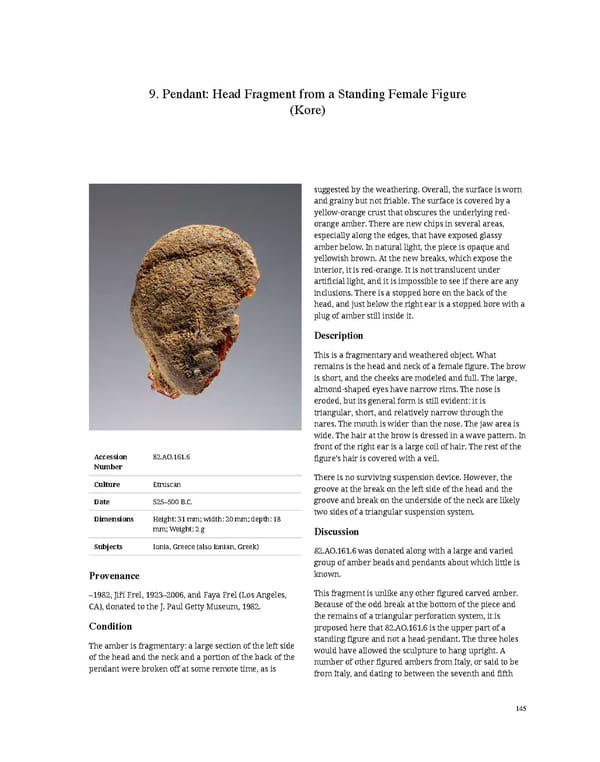9. Pendant: Head Fragment from a Standing Female Figure (Kore) suggested by the weathering. Overall, the surface is worn and grainy but not friable. The surface is covered by a yellow-orange crust that obscures the underlying red- orange amber. There are new chips in several areas, especially along the edges, that have exposed glassy amber below. In natural light, the piece is opaque and yellowish brown. At the new breaks, which expose the interior, it is red-orange. It is not translucent under artificial light, and it is impossible to see if there are any inclusions. There is a stopped bore on the back of the head, and just below the right ear is a stopped bore with a plug of amber still inside it. Description This is a fragmentary and weathered object. What remains is the head and neck of a female figure. The brow is short, and the cheeks are modeled and full. The large, almond-shaped eyes have narrow rims. The nose is eroded, but its general form is still evident: it is triangular, short, and relatively narrow through the nares. The mouth is wider than the nose. The jaw area is wide. The hair at the brow is dressed in a wave pattern. In front of the right ear is a large coil of hair. The rest of the Accession 82.AO.161.6 figure’s hair is covered with a veil. Number There is no surviving suspension device. However, the Culture Etruscan groove at the break on the left side of the head and the Date 525–500 B.C. groove and break on the underside of the neck are likely two sides of a triangular suspension system. Dimensions Height: 31 mm; width: 20 mm; depth: 18 mm; Weight: 2 g Discussion Subjects Ionia, Greece (also Ionian, Greek) 82.AO.161.6 was donated along with a large and varied group of amber beads and pendants about which little is Provenance known. –1982, Jiří Frel, 1923–2006, and Faya Frel (Los Angeles, This fragment is unlike any other figured carved amber. CA), donated to the J. Paul Getty Museum, 1982. Because of the odd break at the bottom of the piece and Condition the remains of a triangular perforation system, it is proposed here that 82.AO.161.6 is the upper part of a The amber is fragmentary: a large section of the left side standing figure and not a head-pendant. The three holes of the head and the neck and a portion of the back of the would have allowed the sculpture to hang upright. A pendant were broken off at some remote time, as is number of other figured ambers from Italy, or said to be from Italy, and dating to between the seventh and fifth 145
 Ancient Carved Ambers in the J. Paul Getty Museum Page 154 Page 156
Ancient Carved Ambers in the J. Paul Getty Museum Page 154 Page 156
